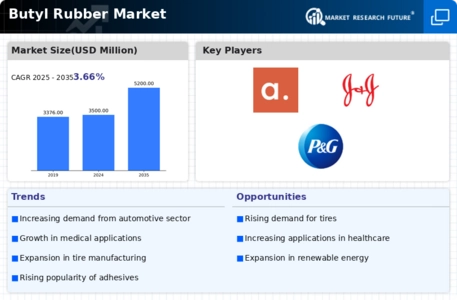Top Industry Leaders in the Butyl Rubber Market

The global butyl rubber market is expected to see continued growth in the coming years, driven by the increasing demand from the automotive and tire industries. Key players are adopting various strategies to gain market share, and the market is likely to see further consolidation and innovation in the coming years.
List of Strategies Adopted
Key players in the butyl rubber market are adopting various strategies to gain a competitive edge, such as:
-
Product development: Companies are focusing on developing new grades of butyl rubber with improved properties, such as higher air retention, low rolling resistance, and better resistance to chemicals and abrasions. -
Expansion: Companies are expanding their production capacities to meet the growing demand for butyl rubber. This includes building new plants, investing in existing facilities, and entering into joint ventures. -
Mergers and acquisitions: Companies are acquiring smaller players to expand their market share and product portfolio. -
Cost reduction: Companies are implementing cost-reduction measures to improve their profitability. This includes reducing raw material costs, improving production efficiency, and streamlining their operations. -
Focus on sustainability: Companies are focusing on developing sustainable production processes and using recycled materials to reduce their environmental impact.
Factors for Market Share
The major factors influencing market share in the butyl rubber market include:
-
Brand reputation: Companies with a strong brand reputation and well-established distribution networks are likely to have a larger market share. -
Product quality: Companies that offer high-quality butyl rubber with consistent performance are likely to have a larger market share. -
Price competitiveness: Companies that offer competitive prices for their butyl rubber are likely to have a larger market share. -
Customer service: Companies that provide excellent customer service are likely to have a higher customer retention rate and, consequently, a larger market share.
These industry players are introducing different tactics such as growth, supply deals, and product releases to achieve full sales.
- Arlanxeo
- JSR Corporation
- China Petrochemical Corporation
- Sibur International GmbH
- Reliance Industries Limited
- PJSC Nizhnekamskneftekhim
- Exxon Mobile Corporation
- Zhejiang Cenway New Synthetic Materials Co., Ltd.
Current Recent Developments
July 2021 MRF, the world's largest tyre manufacturer, has stated that it is considering creating raw materials in collaboration with domestic players to reduce reliance on imports. As part of the import replacement program, the company collaborates with domestic sources to develop raw materials such as sulfur, butyl rubber, microcrystalline wax, and tackifier resin. On the forecast, the business stated that MRF's major markets of West Asia and Africa and the Philippines, Indonesia, and Bangladesh continued to enjoy continuous demand for its products across all categories. Call for tyres in the truck, radial light truck, and motorbike categories grew further, reflecting the company's considerable brand equity in these markets
May 2021 Local voters have granted their approval for PJSC Nizhnekamskneftekhim (NKNH) to proceed with a technical re-equipment. On April 30, the business held a public hearing to examine the project's dimensions and environmental impact assessment. NKNH will reduce butyl rubber production at its production site and convert a 50 kilotonne per annum capacity to halobutyl rubber, a major raw material for tyre manufacturing, as part of the technical improvement. The company's decision is in response to the rising demand for ecologically friendly and cost-effective tubeless tyres. The project, which is planned to be finished in July 2022, will replace obsolete butyl rubber production equipment with new, high-tech, and environmentally friendly equipment.
In August 2023, The Global Platform for Sustainable Natural Rubber (GPSNR) announced that Sri Trang Agro-Industry (STA) had joined its membership as a group in the producer’s processors and trader’s category. By becoming one of the members of GPSNR, STA aims to contribute towards sustainable and inclusive production of natural rubber at scale. There are rubber estates covering about 7,000ha in 19 provinces across Thailand.
In January 2021, ExxonMobil announced a joint venture with SABIC to build a butyl rubber plant in Saudi Arabia with an annual capacity of 400 thousand tons.
On August 15, 2023, The Global Platform for Sustainable Natural Rubber (GPSNR) announced that Sri Trang Agro-Industry (STA) had become its newest member under the category of producers, processors and traders. STA joined GPSNR to achieve a widespread and sustainable production of natural rubber. They have an acreage of about 7000 ha in rubber plantations in Thailand, which is divided among 19 provinces.
On August 10, 2022, Quanex introduced a new moisture protectant for solar panels that can be applied by solar panel manufacturers during the final manufacturing process. SolarGain Edge Sealant LP03 is an adhesive polymer polyisobutylene butyl rubber with integrated desiccant against moisture entry into solar modules thereby helping to protect better cell-conductive coatings as well as connections for improved performance and longer life. According to Quanex, applying this sealant can give an additional ten to fifteen years of useful life to a panel.
In January 2021, ExxonMobil, along with SABIC, declared their intention to construct a butyl rubber-producing facility in Saudi Arabia, which would produce up to 400 thousand tons per year.
In July 2020, Mitsui Chemicals completed the acquisition of Itoh Butyl Chemicals Co., Ltd – one of the largest Japanese producers of butyl rubbers.
In September 2019 Arlanxeo plant located in Marl (Germany) joint production venture between Saudi Aramco and Lanxess announced its plans on increasing butyl capacities at its site.
In September 2019, TASS reported that Russia's petrochemical giant Sibur and Reliance Industries Ltd. from India, joined hands for butyl rubber production which started at the integrated joint petrochemical plant "Reliance Sibur Elastomers Private Ltd" in Jamnagar (India).
November 2019, Sibur and Tatneft closed the deal for selling some Togliatti-based synthetic rubber production assets of Sibur. Tatnef bought also facilities for butadiene, isoprene, high octane fuel component and other intermediates besides many types of rubbers from Sibur company. The factory can produce 82 thousand tons per annum of IIR75 butyl rubber and ESBR60 emulsion styrene butadiene in Russia.

